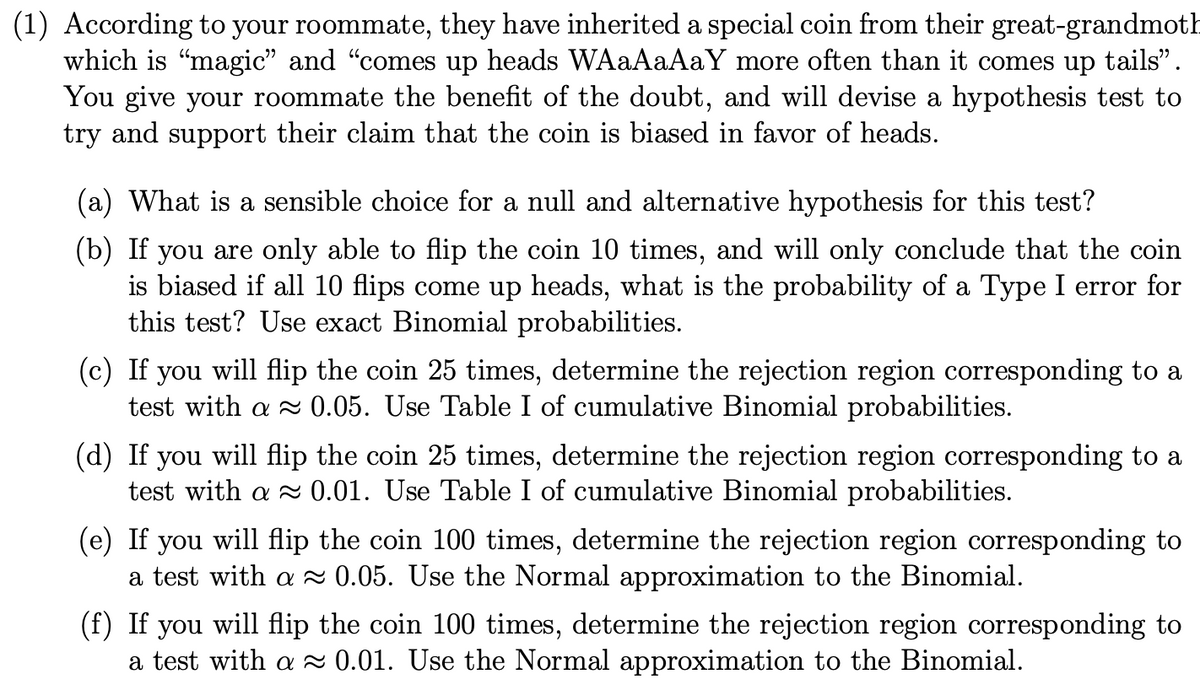(1) According to your roommate, they have inherited a special coin from their great-grandmoth which is "magic" and "comes up heads WAaAaAaY more often than it comes up tails". You give your roommate the benefit of the doubt, and will devise a hypothesis test to try and support their claim that the coin is biased in favor of heads. (a) What is a sensible choice for a null and alternative hypothesis for this test? (b) If you are only able to flip the coin 10 times, and will only conclude that the coin is biased if all 10 flips come up heads, what is the probability of a Type I error for this test? Use exact Binomial probabilities. (c) If you will flip the coin 25 times, determine the rejection region corresponding to a test with a 0.05. Use Table I of cumulative Binomial probabilities. (d) If you will flip the coin 25 times, determine the rejection region corresponding to a test with a 0.01. Use Table I of cumulative Binomial probabilities. (е) If a test with a 0.05. Use the Normal approximation to the Binomial. you will flip the coin 100 times, determine the rejection region corresponding to (f) If you will flip the coin 100 times, determine the rejection region corresponding to a test with a 0.01. Use the Normal approximation to the Binomial.
(1) According to your roommate, they have inherited a special coin from their great-grandmoth which is "magic" and "comes up heads WAaAaAaY more often than it comes up tails". You give your roommate the benefit of the doubt, and will devise a hypothesis test to try and support their claim that the coin is biased in favor of heads. (a) What is a sensible choice for a null and alternative hypothesis for this test? (b) If you are only able to flip the coin 10 times, and will only conclude that the coin is biased if all 10 flips come up heads, what is the probability of a Type I error for this test? Use exact Binomial probabilities. (c) If you will flip the coin 25 times, determine the rejection region corresponding to a test with a 0.05. Use Table I of cumulative Binomial probabilities. (d) If you will flip the coin 25 times, determine the rejection region corresponding to a test with a 0.01. Use Table I of cumulative Binomial probabilities. (е) If a test with a 0.05. Use the Normal approximation to the Binomial. you will flip the coin 100 times, determine the rejection region corresponding to (f) If you will flip the coin 100 times, determine the rejection region corresponding to a test with a 0.01. Use the Normal approximation to the Binomial.
MATLAB: An Introduction with Applications
6th Edition
ISBN:9781119256830
Author:Amos Gilat
Publisher:Amos Gilat
Chapter1: Starting With Matlab
Section: Chapter Questions
Problem 1P
Related questions
Question
1)

Transcribed Image Text:(1) According to your roommate, they have inherited a special coin from their great-grandmoth
which is "magic" and "comes up heads WAaAaAaY more often than it comes up tails".
You give your roommate the benefit of the doubt, and will devise a hypothesis test to
try and support their claim that the coin is biased in favor of heads.
(a) What is a sensible choice for a null and alternative hypothesis for this test?
(b) If you are only able to flip the coin 10 times, and will only conclude that the coin
is biased if all 10 flips come up heads, what is the probability of a Type I error for
this test? Use exact Binomial probabilities.
(c) If you will flip the coin 25 times, determine the rejection region corresponding to a
test with a 0.05. Use Table I of cumulative Binomial probabilities.
(d) If you will flip the coin 25 times, determine the rejection region corresponding to a
test with a 0.01. Use Table I of cumulative Binomial probabilities.
(e) If you will flip the coin 100 times, determine the rejection region corresponding to
a test with a ~ 0.05. Use the Normal approximation to the Binomial.
(f) If you will flip the coin 100 times, determine the rejection region corresponding to
a test with a 2 0.01. Use the Normal approximation to the Binomial.
Expert Solution
This question has been solved!
Explore an expertly crafted, step-by-step solution for a thorough understanding of key concepts.
Step by step
Solved in 5 steps with 5 images

Recommended textbooks for you

MATLAB: An Introduction with Applications
Statistics
ISBN:
9781119256830
Author:
Amos Gilat
Publisher:
John Wiley & Sons Inc

Probability and Statistics for Engineering and th…
Statistics
ISBN:
9781305251809
Author:
Jay L. Devore
Publisher:
Cengage Learning

Statistics for The Behavioral Sciences (MindTap C…
Statistics
ISBN:
9781305504912
Author:
Frederick J Gravetter, Larry B. Wallnau
Publisher:
Cengage Learning

MATLAB: An Introduction with Applications
Statistics
ISBN:
9781119256830
Author:
Amos Gilat
Publisher:
John Wiley & Sons Inc

Probability and Statistics for Engineering and th…
Statistics
ISBN:
9781305251809
Author:
Jay L. Devore
Publisher:
Cengage Learning

Statistics for The Behavioral Sciences (MindTap C…
Statistics
ISBN:
9781305504912
Author:
Frederick J Gravetter, Larry B. Wallnau
Publisher:
Cengage Learning

Elementary Statistics: Picturing the World (7th E…
Statistics
ISBN:
9780134683416
Author:
Ron Larson, Betsy Farber
Publisher:
PEARSON

The Basic Practice of Statistics
Statistics
ISBN:
9781319042578
Author:
David S. Moore, William I. Notz, Michael A. Fligner
Publisher:
W. H. Freeman

Introduction to the Practice of Statistics
Statistics
ISBN:
9781319013387
Author:
David S. Moore, George P. McCabe, Bruce A. Craig
Publisher:
W. H. Freeman